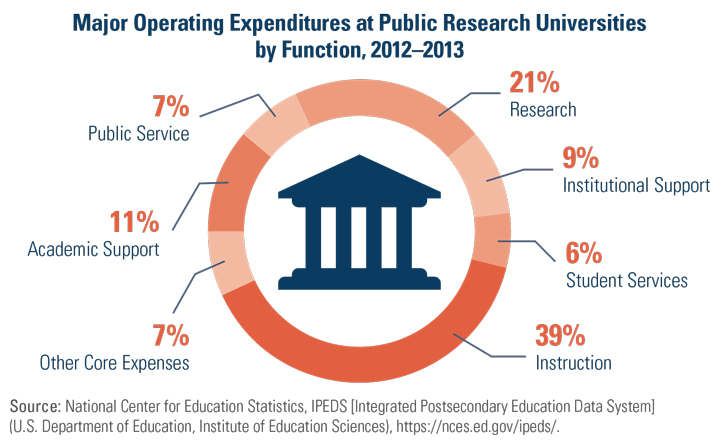Section 5: Public Research Universities Value Responsible Spending
Public research universities have cut costs in recent years by:
|
The education of graduate students is essential to the research mission and to the production of future faculty members, and therefore to the health of the entirety of higher education. As doctoral degree–granting institutions, public research universities have less flexibility to absorb budget reductions than do large comprehensive universities. Public research universities must maintain high faculty levels because graduate training requires intense faculty-student interaction. But public research universities have suffered massive budget cuts; state cuts have reduced total funding for public research universities by 20 percent per enrolled student over the past decade.38 Forty-six of the fifty states cut support for higher education from 2008 to 2013, some by more than one-third.
The main driver of tuition increases has been the loss of state appropriations, which have reduced per-student support by as much as 40 percent.39 Tuition increases alone cannot make up the difference. It is a widely held public belief that the state provides the majority of support for public universities. But with state appropriations in many cases making up less than 20 percent of public research university budgets, and in some cases even less than 10 percent,40 this is clearly a myth; new funding models are needed to increase resources.
Many public research universities have lowered administrative and operational expenses by finding new efficiencies. For example, between 2006 and 2009, the Arizona Board of Regents gained a cost savings of 38 percent for the state’s public universities by redesigning its course offerings.41 Collaborations and shared services also reduce costs: the Library Service Center, a joint venture between the Georgia Institute of Technology and Emory University, will house materials available to students, faculty, and staff at both universities.42 These findings are supported by the U.S. News & World Report’s rankings of the most efficient colleges and universities, which are dominated by public research universities.43

|
ENDNOTES
38 National Science Board, Diminishing Funding and Rising Expectations, 10.
39 Center on Budget and Policy Priorities, States are Still Funding Higher Education below Pre-Recession Levels (Washington, D.C.: Center on Budget and Policy Priorities, 2014), http://www.cbpp.org/sites/default/files/atoms/files/5-1-14sfp.pdf.
40 University of Virginia Office of Public Affairs, “Financing the University 101: The University of Virginia,” http://www.virginia.edu/finance101/state.html.
41 The National Center for Academic Transformation, “Arizona Board of Regents: Learner-Centered Education Course Redesign Initiative,” http://www.thencat.org/States/AZ/ABOR_Savings.htm.
42 “Emory, Georgia Tech to Open Joint Library Service Center,” Emory News Center, November 19, 2014, http://news.emory.edu/stories/2014/11/upress_library_service_center/index.html.
43 Robert Morse and Diane Tolis, “Data Show Which Top-Ranked Colleges Operate Most Efficiently,” U.S. News & World Report, January 15, 2015, http://www.usnews.com/education/blogs/college-rankings-blog/2015/01/15/data-show-which-top-ranked-colleges-operate-most-efficiently.